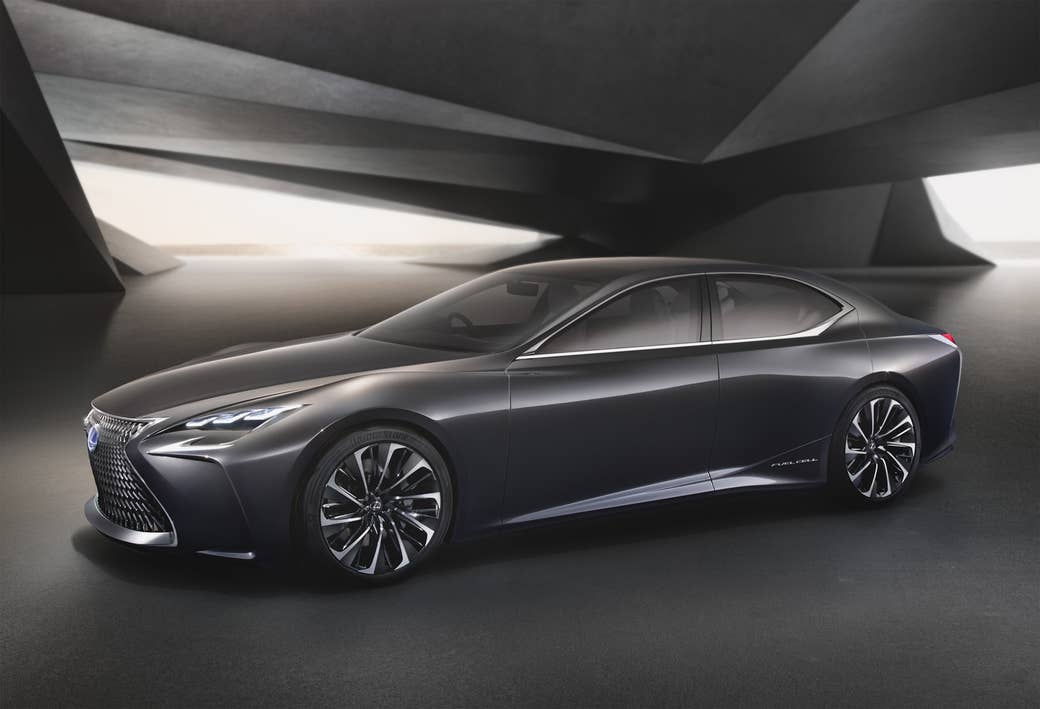
The key to your car is an app. The app scans your face, confirming that you are its owner before it unlocks and starts your car. When it starts, the car glides to where you stand and stops, the handleless driver's side door opening automatically. This machine appears to be the car of the future, but it is not. This car is not the next big thing.
You know the scene in fantasy movies where the ground starts lurching unpredictably and it turns out our man is actually on top of some gigantic living thing, some creature too massive for him to take on even though he is literally standing on it? That's always kinda weird, right? Like, "SMH. This dummy didn't even realize that was a giant monster he was on, and not just a big-ass rock." I hate to have to tell you this, but right now you're that dummy standing on that giant.
It’s not your fault. The internet has made us all experts at focusing on the trees while missing the forest completely, and that’s what you’re doing right now. Important is one of those words like “indie” that’s lost all its snap. A lot of the times when we say “important,” what we really mean is “interesting,” but we also understand intuitively that there is a second kind of important out there, the kind of thing whose impact in the world doesn’t depend on whether you care about it right now or not. These are things like global warming research or sustainable farming that are not important because they’re interesting; they’re important just because, well, they are.
Then there are certain things that exist within both definitions of “important” at the same time. Take, for example, whatever device you’re reading this on, that magical object that’s both little-I important and capital-I Important — that’s the kind of important that hydrogen fuel cell technology is. Self-opening doors won’t make the car of the future — the technology that powers it will. That’s the next big thing. That’s the massive living thing you’re standing on right now, and you don’t even realize it yet. But soon you will, because it’s waking up.

Let’s get some terms and definitions out of the way up top. Industry professionals refer to these cars either as FCVs (Fuel Cell Vehicles) or FCEVs (Fuel Cell Electric Vehicles). Those terms are pretty much interchangeable, and they distinguish this type of car from BEVs or BPEVs (Battery Powered Electric Vehicles — more on the differences between these two types of cars later). As for how FCEVs work, brace yourself, because this part is so facepalmingly simple that when I asked experts Bill Elrick and Chris White of the California Fuel Cell Partnership about it, I felt a little dumb when I heard their answer. But here it is: You’re gonna fill the hydrogen tank in your car at a pump just like at a gas station. In fact, they’ll be at gas stations, right next to the gas pumps, until, y’know, those aren’t a thing anymore.
What happens next is the sciencey part, so I’ll let one of our experts, Chris White, explain it: "[The] hydrogen goes into one side of the fuel cell stack … [and] air goes into the other side, and hydrogen is naturally attracted to the oxygen in the air. To get to that oxygen it moves through a series of plates, and those plates force the hydrogen molecule to separate into electrons and protons. The protons just move right on through, but all electricity is is an excited electron … so we grab that excited electron and direct [some of] it … to the electric motor where it powers the car, but the rest of it goes inside the cabin where it runs the air conditioner, the sound system, the power windows — anything that takes electricity. When the electron has done its job, it comes back into the fuel cell stack, it meets up with a proton and the oxygen that’s been waiting for it. It makes a new molecule: water. And that’s what comes from the tailpipe of the car. It’s water so clean you can drink it."
So, two things. First, there’s no more science. I promise. Second, how bonkers simple is that? You use oxygen to attract hydrogen, you split the hydrogen, you grab the energy that splitting hydrogen produces, then you use what’s left to make water. That’s it.
Here, look:
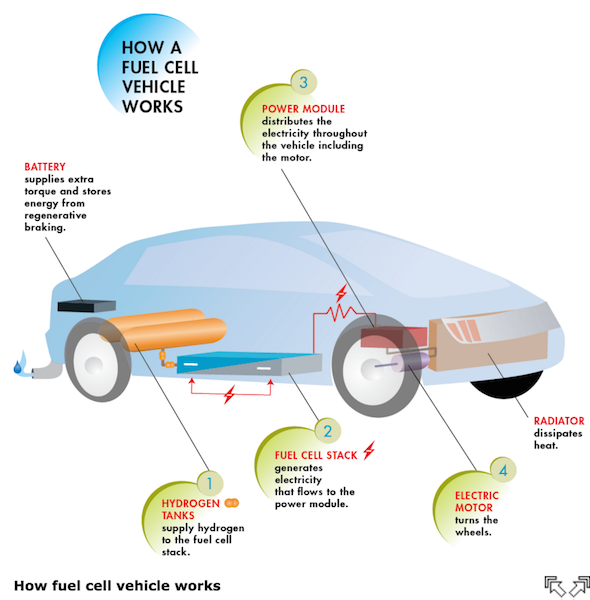
Or, if you want the fancier, more visually stimulating version, look at this:

A battery stores electricity that’s generated somewhere else, while a fuel cell stack produces electricity inside the vehicle. So, yes, for all intents and purposes, a hydrogen car is an electric car, which means the whole controversy about hydrogen versus electric is, in some ways, a false debate.
While we’re at it, let’s deal with another misconception: that replacing a combustion engine with a fuel cell is essentially swapping one engine out for another. Anyone who tells you this is truly basic. The correct comparison isn’t the difference between one engine and another — it’s the difference between your landline (google it) and a smartphone. Because for both FCVs and BEVs, there are massive advantages to being powered by electricity.
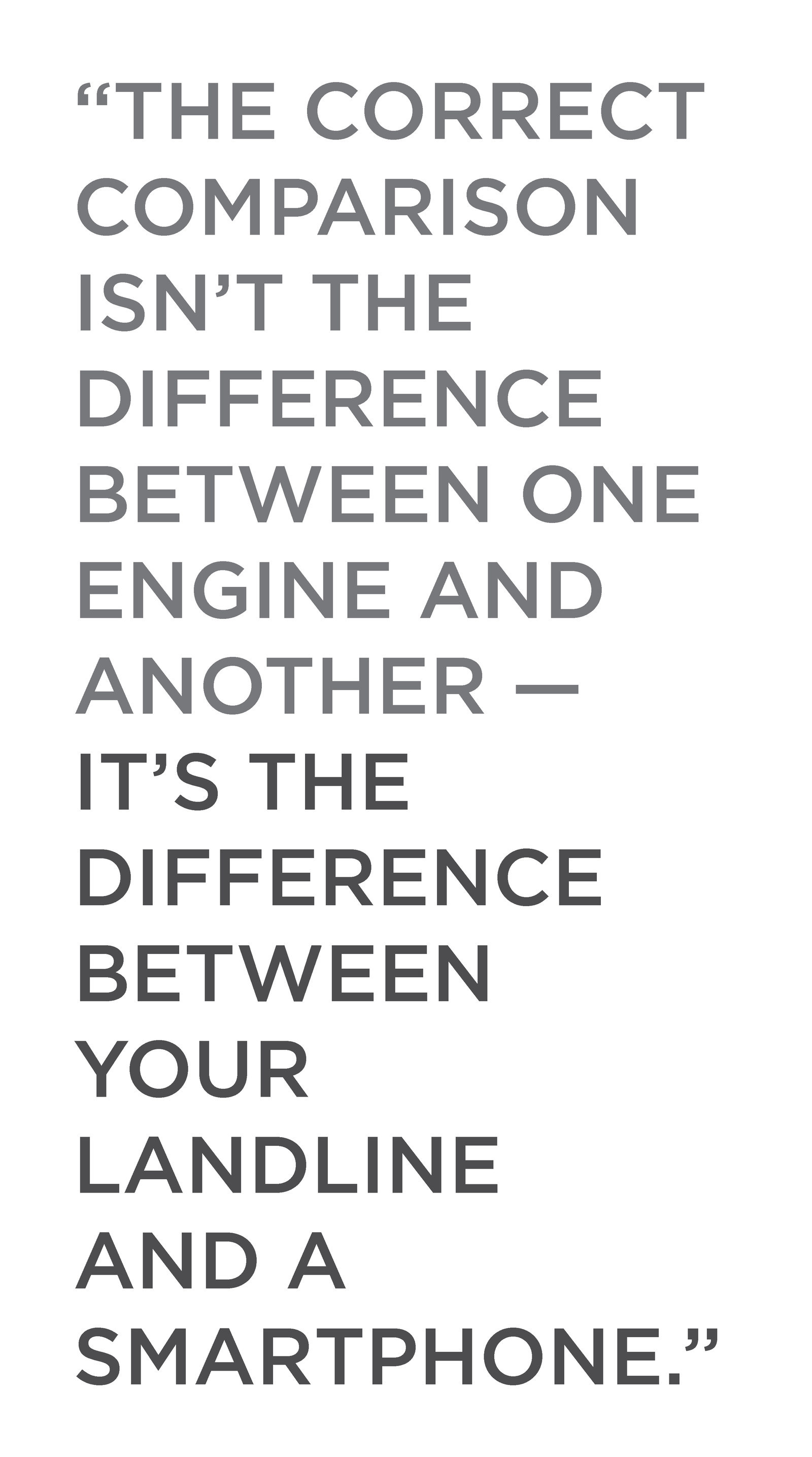
This is where the design revolution comes in. We’ve been building cars with combustion engines ever since the Model T rolled off the line in 1908. Electric cars are inherently less mechanical, meaning that their parts don’t all need to be physically attached to each other to function. The parts can, instead, communicate electronically. If this sounds abstract, think about a landline phone. A combustion engine is the power source, the part connected to the wall, and the wheels of your car are like the receiver — they literally connect to the power source through that weird pigtail cord (just google it already). Getting rid of the combustion engine is like cutting the cord, and it has unleashed a wave of what-other-rules-can-we-break creativity among car designers who have gone low-key bananas with new cool-as-hell features.
“It essentially creates a ‘whiteboard’ start over, and [engineers] can play with [the elements of a car] in ways we probably haven’t even imagined, let alone seen yet,” Elrick tells me. So, fine, let’s get rid of the axles and put individual electric-powered motors on each wheel. Fewer friction points also means fewer breakdowns, which means lower maintenance costs. Since we now have fewer parts and we can move the fuel cell stack anywhere, let’s tuck it in a corner and make the car’s cabin gigantic, like the cockpit of a luxury spaceship. Storage space for days. And since our fuel cell stack kicks out extra electricity, why not just use the surplus to make these lil’ devils Wi-Fi hotspots? What if we plug it in every night not to charge it, but as an emergency generator for our house in case the power goes out?

Well, there are a few differences. Probably the biggest one is that an FCEV can drive just about the same distance as your current car before you have to stop to refill the hydrogen tank, which is (generally) longer than the range of many BPEVs. Also, because the refueling process is so similar between hydrogen and gas, FCEVs fill in just a few minutes, like your current car. A battery-powered electric, according to Elrick and White, can take up to four to six hours to charge.
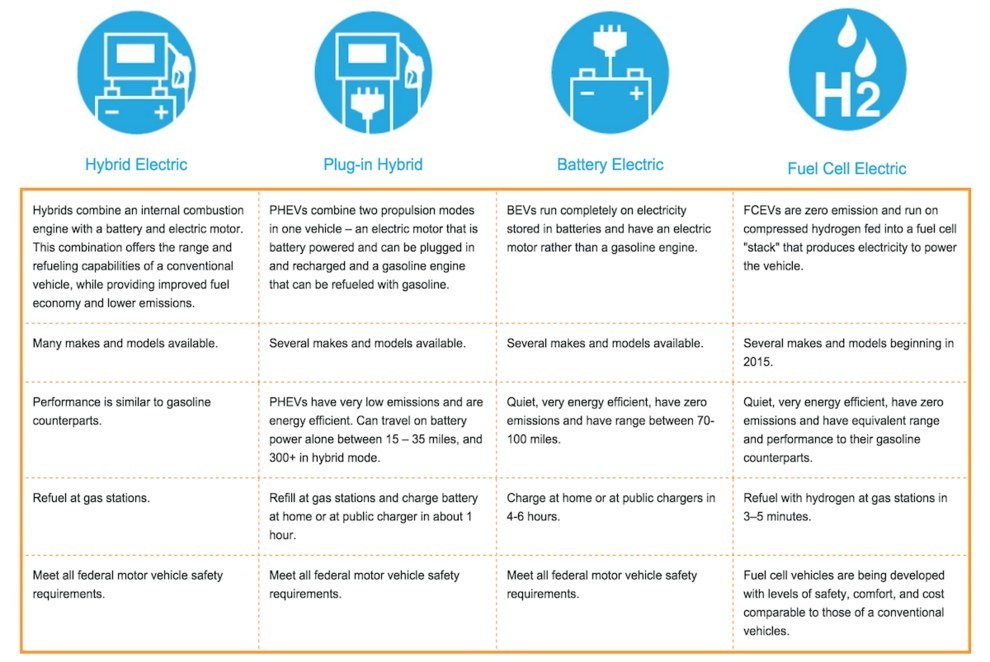
Elrick, though, believes that comparing FCEVs and battery-powered cars would be getting ahead of ourselves: “I would say [FCEV is] one of the most promising [alternative fuel technologies] … but it’s part of what is recognized as an all-of-the-above strategy. Meaning we need lots of compliments for our energy use going forward. ... It doesn’t rule the others out. ... If you look across the automotive world, big companies are producing both.”
“[With an FCEV] you’re getting the range and refill time that’s similar to a gas car, but you’re also getting the power and performance … of a battery-powered electric vehicle,” White adds. “The convenience of a battery electric vehicle is that you don’t have to go to a station. You can fill it at home or at work.”
Because each of these technologies has strengths and weaknesses, neither of them will soon be ready to replace the combustion engine entirely by itself. In the short term, then, it doesn’t make sense to view these technologies as direct competitors or start figuring out which one will come out on top in a new automotive marketplace. We’re not there...yet. White sums up: “We see a future where people are going to have both.”

Did you not hear the part where our expert said that the only exhaust coming from this car is drinkable water? All FCEVs are “zero emission,” which means literally no exhaust fumes. FCEVs don’t even need exhaust systems the way we think of them today. That could mean a massive reduction in air pollution, which produces everything from smog to greenhouse gasses. At this point in 2015, we pretty much all agree that the effects of air pollution are essentially beyond reasonable debate, and motor vehicles account for up to 50% of that pollution. Even a moderate reduction would mean cleaner air, and as alternative fuel technology ramps up and enjoys wider adoption, we’ll be talking about much more than a moderate reduction.
Then there’s the fact that combustion engines run on gas, which comes from oil, which comes from drilling. Some studies estimate that we’re only about 50 years from exhausting the world’s oil supply that we can extract by conventional drilling. We won’t run out of oil then, but we will use more dangerous and expensive methods to get it out of the ground. Even if that doesn’t cause health or environmental problems, it’s going to drive up gasoline costs. Hydrogen is the most abundant element in the universe, so while it’s not technically inexhaustible (spoiler alert: nothing is) we don’t need to worry about running out of it soon…or ever.
Even better, there’s no “right way” to obtain hydrogen for fuel. Most of the hydrogen that powers FCEVs today comes from natural gas, but wind-, solar-, and hydroelectric-powered techniques are being developed and streamlined. “You can grab [hydrogen] from all sorts of things,” says Elrick. “We’re only limited by our imagination and capability of where and how we grab it.” White adds: “One of the things that’s really cool about hydrogen is that we can make it from garbage. You can make it from sewage, you can make it from cow manure, so long as people are throwing things away and animals are poopin’, we’re not going to run out.” Right now, 33% of the hydrogen produced in California comes from renewable sources like methane. And that number’s only going up.

How ‘bout efficiency? Only 19%-25% of the energy released from burning gasoline actually powers your car. The other roughly 80% — or four-fifths — of the gas you buy is essentially wasted in the process or becomes a potentially harmful pollutant. Sound like a good deal? Less wasted energy = more brunch money. That simple. By contrast, fuel cells are more than three times this efficient, close to 60%, and the rest becomes water. Free water. Buy a plant, make some coffee, go nuts.
How about the fact that a stable supply of fuel means no reason for price fluctuations? What if fueling up your car cost the exact same amount of cash every time you did it? You could budget for it the same way you factor out your rent or your phone bill. This idea becomes crazy exciting when you scale it up to the level of public transportation. If cities knew at the beginning of the year exactly how much they would spend on fuel, their budgets would become more stable. Combine that with the reduced maintenance costs we already discussed and use that money to put more buses on the road. More buses and fewer breakdowns equals more routes, less crowding, more stops, and more reliability. Now throw in the increased space that removing the engine and transmission provides and the fact that FCEV buses can and will be Wi-Fi enabled.
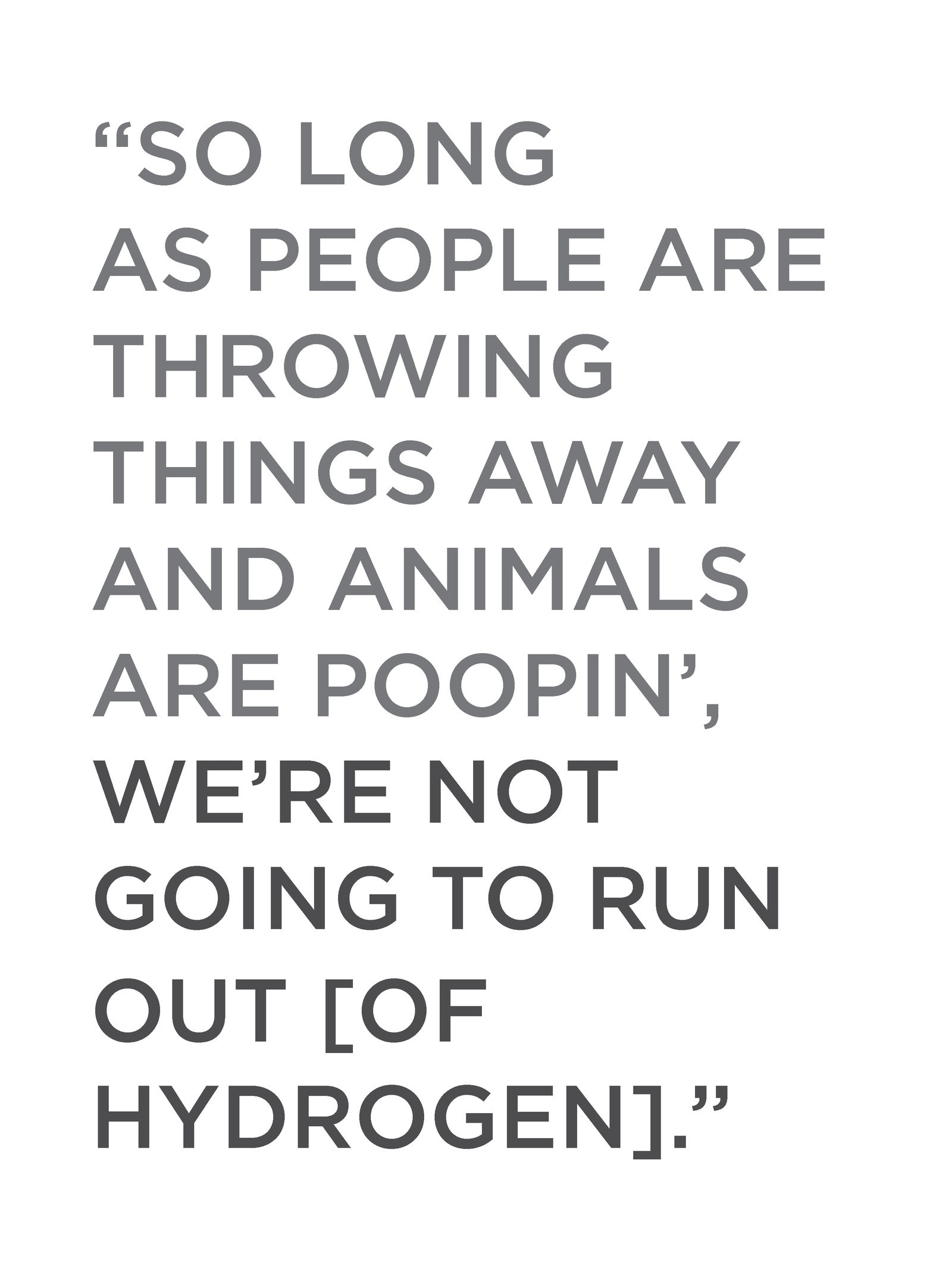
So now we have a bus that runs on time, drops you right in front of your building, doesn’t cram you in like a sardine, and lets you play mobile games (or check BuzzFeed) on your commute without chewing through your data plan. You’re telling me you’re not taking that bus? I’m taking that bus. When enough people start taking that bus, public transportation expands, the number of cars on the road decreases, and traffic jams become a thing we talk about nostalgically like dial-up modems. Affordable, reliable, scalable infrastructure with zero emissions? This kind of thinking isn’t game-changing, it’s game-ending. Game over. Find another game.
Or how about just because these cars are gonna be dope? We’ve already talked about facial recognition and auto-parking. How about a screen that recognizes your hand movements to change gear? How about steering your car with a joystick instead of a wheel? What about voice-controlled everything? Oh, and the first self-driving, first self-directing, first sit-in-the-back-and-read-while-I-drive-you-to-the-movies car? Yeah, that’s gonna be an electric car. These things are coming, and soon. This is the giant you’re standing on.

FCEVs, like all cars driven today, agree to meet safety standards and undergo rigorous testing and inspection by organizations with impressive titles like The Society of Automotive Engineers and The National Highway Traffic and Safety Administration. These people don’t play. Here’s what the Department of Energy Efficiency and Renewable Energy (see what I mean about the titles?) says on the topic: “Like gasoline or natural gas, hydrogen is a fuel that must be handled properly. It can be used as safely as other common fuels when simple guidelines are followed.” Hydrogen is also nontoxic, nonpoisonous, and it disperses much more quickly than gasoline fumes, meaning that in most situations it is actually less likely to ignite than gasoline.
So what does all this mean? It means that hydrogen can be safely applied to fuel cell technology if you follow the rules. It means that there are many, many redundant systems of public and private checks to make sure that automakers are following those rules. Or, as White puts it, “There was a time when people thought gasoline cars were extremely dangerous … and electricity was far too dangerous to put into your house. ... There are always people who are worried about something new, [and] there are other people who embrace something new.”

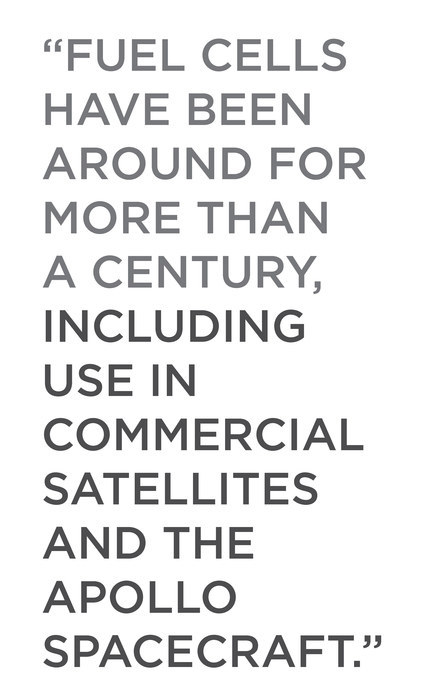
So, this is awkward, and, again, I’m not here to preach. But the reason you’re not driving one yet is that you didn’t really care about this until (hopefully) now. Up until now, you’ve been focused on touchscreens and sound systems. You were too busy looking at the details to notice that the thing you were standing on wasn’t just a big rock. But fuel cells themselves aren’t new. In fact, fuel cells have been around for more than a century, having been used already on both commercial satellites and the Apollo spacecrafts. What’s more, the U.S. currently produces, processes, and uses about 9 million tons of hydrogen per year. So neither the fuel nor the fuel cell is exactly “futuristic.” What leads us to the future is the only thing that ever has: the amount of public interest in solving this problem, and the amount of money that institutions — both public and private — are investing to put FCEVs on the road and hydrogen fueling stations around the world.
"I think this is the tipping point,” says Elrick, “the point where the first sale happens, the point where the first infrastructure network [is developed]. That’s the true tipping point of the launch.” The state of California alone aims to have 1.5 million zero-emission vehicles on the road in the next decade, and other traditional automaking powerhouses like Japan and Germany have announced even more ambitious goals. Shorter timelines, faster adoption. Or, as Elrick puts it, “Electric vehicles, both fuel cells and batteries, are the wave of the future in such a way that the auto companies are making sure that they can provide those technologies to anyone and everyone.” The era of alternative fuel vehicles has dawned because, finally, we’ve all agreed that sustainable, renewable energy is both little-I and big-I important. Because you and I and everyone we know understands now that the future is our business.
The fuel cell giant is waking up.


